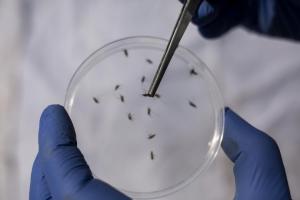Malaria deaths fall, but vector resistance to insecticides a worrying trend
Ethiopia’s malaria response, already disrupted by the impacts of COVID-19, is grappling with the multi-faceted challenges of an ongoing uptick in new cases, complicated by vector resistance to insecticides.
Driven by the continued fallout of pandemic-related programme disruptions, armed conflict, and displacement, Ethiopia recorded a 32,5% increase in confirmed malaria cases between 2021 and 2022, from 1,1m to 1,5m. To date in 2023, reported malaria cases have increased by 150% and 120%, respectively, compared to the same periods in 2021 and 2022.
Compounded by the emergence of vector resistance to insecticides, the statistics are a disappointment for the country, says Dr. Bekele Worku, WHO’s national project officer (National Professional Officer-NPO) in Ethiopia.
Between 2017 and 2019, the number of confirmed malaria cases had fallen by 42.7%, to just over 900 000, thanks to improved uptake, use, and quality of control interventions.
But in 2022, the Amhara region alone reported 960,000 cases, twice as many as the previous year. WHO epidemiologist Tsehaye Alemu says the causes go beyond a concomitant increase in the number of internally displaced persons and significant population movements due to conflict.
“The other reasons for the increase include the lack of budget for purchasing indoor residual spray chemicals from abroad to replace the existing ones, which are becoming increasingly less effective (not sensitive, )especially to the new Anopheles stephensi species,” he says.
Unlike the other main mosquito vectors of malaria, this vector thrives in urban settings. It is also capable of transmitting both Plasmodium falciparum and P. vivax malaria parasites.
The spike in malaria cases also comes when parts of Ethiopia have been hard-hit by extreme weather events. Early this month, intense rains and flash flooding destroyed homes and livestock in many of the country’s rural communities on the back of the worst drought in 40 years.
About 24 million people live in Ethiopia’s drought-impacted regions of Oromia, Somali, and the Southern Nations, Nationalities, and People’s Region (SNNP). WHO is assisting in preventing and mitigating multi-disease outbreaks and malnutrition arising from this emergency.
On a positive note, the increases in case numbers have not translated to increased death rates, which Worku says could be due to the highly efficacious first-line drug Artemether-Lumefantrine plus single dose Primaquine being used, along with improved care in health facilities for those admitted with severe malaria.
Between 2017 and 2019, the number of malaria deaths in Ethiopia fell by 40%, from 356 to 213, with 180 deaths reported in 2022.
Now, however, Worku says the response is being challenged by the expansion of malaria into previously malaria-free areas, complications in the use and reliability of rapid diagnostic tests, as well as insecticide resistance.
Only a few insecticides continue to work well, with almost all conventional insecticides no longer effective against local vectors.
“We are continuously testing the efficacy of insecticides and we use the most appropriate insecticide in the most appropriate place, based on that efficacy,” he explains. “This varies in geographical areas, so we have to be alert to the fact that because an insecticide works in one district, it may not work in another.”
Meanwhile, in the eastern part of the country, they have discovered the new Anopheles stephensi vector, which is proving resistant to almost all conventional insecticides used for indoor residual spraying in Ethiopia.
“Overall, one cannot say a lot on this vector as it has not been well studied,” says Dr Worku.
Originally native to South Asia and parts of the Arabian Peninsula, it has been expanding its range over the last decade, with detections reported in Djibouti (2012), Ethiopia and Sudan (2016), and Somalia (2019).
All these countries, except Nigeria, where the vector was detected in 2020, are in the greater Horn of Africa, which is currently prone to droughts and flooding.
“Generally, we know that drought facilitates the occurrence of malaria epidemics. Rivers and streams begin to dry up, leaving small pools of water that facilitate vector breeding,” Worku explains.
This is exacerbated by the fact that populations are displaced during droughts, constantly moving in search of water and food for themselves and their livestock, potentially introducing parasites to new areas. During emergencies accessibility to available interventions and treatment could be compromised.
Dr Nonhlanhla Dlamini, WHO representative for Ethiopia, highlights the need for interventions to continue. "We need to invest in malaria prevention and control, innovate new approaches, and implement strategies to help marginalized groups who are most at risk. By doing this, we can work towards eradicating malaria," she says.
Communications Officer
WHO Ethiopia
Email: gebremichaela [at] who.int (gebremichaela[at]who[dot]int)
Communication Consultant
johwaw [at] who.int (johwaw[at]who[dot]int)
WHO Regional Office for Africa
